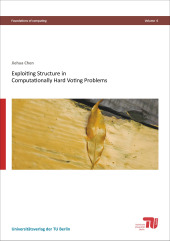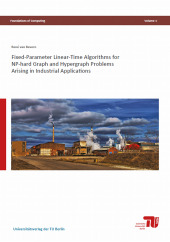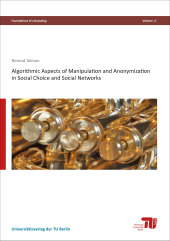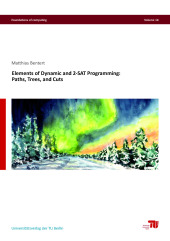Be sparse! Be dense! Be robust!
Elements of parameterized algorithmics
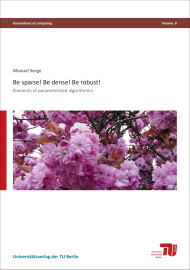
Format: 14,8 x 21,0 cm
Publishing year: 2017
In this thesis we study the computational complexity of five NP-hard graph problems. It is widely accepted that, in general, NP-hard problems cannot be solved efficiently, that is, in polynomial time, due to many unsuccessful attempts to prove the contrary. Hence, we aim to identify properties of the inputs other than their length, that make the problem tractable or intractable. We measure these properties via parameters, mappings that assign to each input a nonnegative integer. For a given parameter k, we then attempt to design fixed-parameter algorithms, algorithms that on input q have running time upper bounded by f(k(q)) * |q|^c , where f is a preferably slowly growing function, |q| is the length of q, and c is a constant, preferably small. In each of the graph problems treated in this thesis, our input represents the setting in which we shall find a solution graph. In addition, the solution graphs shall have a certain property specific to our five graph problems. This property comes in three flavors. First, we look for a graph that shall be sparse! That is, it shall contain few edges. Second, we look for a graph that shall be dense! That is, it shall contain many edges. Third, we look for a graph that shall be robust! That is, it shall remain a good solution, even when it suffers several small modifications. Be sparse! In this part of the thesis, we analyze two similar problems. The input for both of them is a hypergraph H , which consists of a vertex set V and a family E of subsets of V , called hyperedges. The task is to find a support for H , a graph G such that for each hyperedge W in E we have that G[W ] is connected. Motivated by applications in network design, we study SUBSET INTERCONNECTION DESIGN, where we additionally get an integer f , and the support shall contain at most |V| – f + 1 edges. We show that SUBSET INTERCONNECTION DESIGN admits a fixed-parameter algorithm with respect to the number of hyperedges in the input hypergraph, and a fixed-parameter algorithm with respect to f + d , where d is the size of a largest hyperedge. Motivated by an application in hypergraph visualization, we study r-OUTERPLANAR SUPPORT where the support for H shall be r -outerplanar, that is, admit a edge-crossing free embedding in the plane with at most r layers. We show that r-OUTER-PLANAR SUPPORT admits a fixed-parameter algorithm with respect to m + r , where m is the number of hyperedges in the input hypergraph H. Be dense! In this part of the thesis, we study two problems motivated by community detection in social networks. Herein, the input is a graph G and an integer k. We look for a subgraph G” of G containing (exactly) k vertices which adheres to one of two mathematically precise definitions of being dense. In mu-CLIQUE, 0 < mu <= 1, the sought k-vertex subgraph G” should contain at least mu time k choose 2 edges. We study the complexity of mu-CLIQUE with respect to three parameters of the input graph G: the maximum vertex degree delta, h-index h, and degeneracy d. We have delta >= h >= d in every graph and h as well as d assume small values in graphs derived from social networks. For delta and for h, respectively, we obtain fixed-parameter algorithms for mu-CLIQUE and we show that for d + k a fixed-parameter algorithm is unlikely to exist. We prove the positive algorithmic results via developing a general framework for optimizing objective functions over k-vertex subgraphs. In HIGHLY CONNECTED SUBGRAPH we look for a k-vertex subgraph G” in which each vertex shall have degree at least floor(k/2)+1. We analyze a part of the so-called parameter ecology for HIGHLY CONNECTED SUBGRAPH, that is, we navigate the space of possible parameters in a quest to find a reasonable trade-off between small parameter values in practice and efficient running time guarantees. The highlights are that no 2^o(n) * n^c -time algorithms are possible for n-vertex input graphs unless the Exponential Time Hypothesis fails; that there is a O(4^g * n^2)-time algorithm for the number g of edges outgoing from the solution G; and we derive a 2^(O(sqrt(a)log(a)) + a^2nm-time algorithm for the number a of edges not in the solution. Be robust! In this part of the thesis, we study the VECTOR CONNECTIVITY problem, where we are given a graph G, a vertex labeling ell from V(G) to {1, . . . , d }, and an integer k. We are to find a vertex subset S of V(G) of size at most k such that each vertex v in V (G)S has ell(v) vertex-disjoint paths from v to S in G. Such a set S is useful when placing servers in a network to satisfy robustness-of-service demands. We prove that VECTOR CONNECTIVITY admits a randomized fixed-parameter algorithm with respect to k, that it does not allow a polynomial kernelization with respect to k + d but that, if d is treated as a constant, then it allows a vertex-linear kernelization with respect to k.
